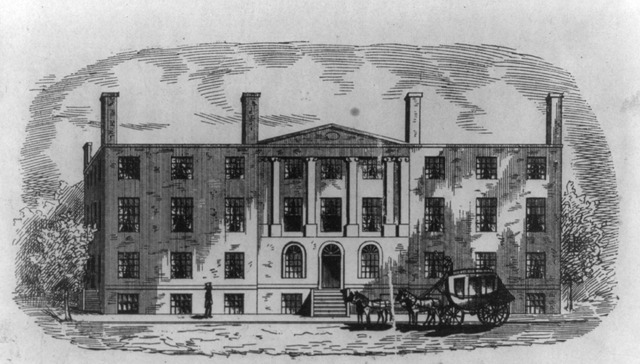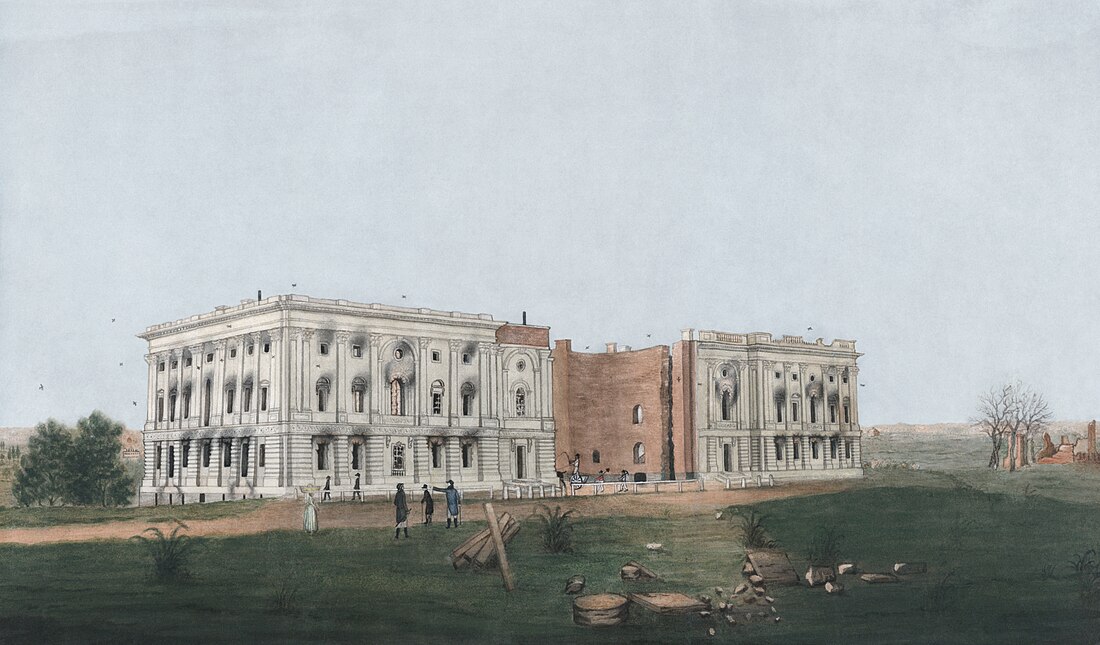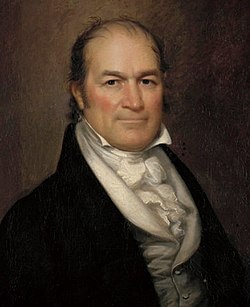Top Qs
Timeline
Chat
Perspective
13th United States Congress
1813–1815 meeting of U.S. legislature From Wikipedia, the free encyclopedia
Remove ads
The 13th United States Congress was a meeting of the legislative branch of the United States federal government, consisting of the United States Senate and the United States House of Representatives. It met in Washington, D.C. from March 4, 1813, to March 4, 1815, during the fifth and sixth years of James Madison's presidency. The apportionment of seats in the House of Representatives was based on the 1810 United States census. Both chambers had a Democratic-Republican majority. The first two sessions were held at the Capitol building while the third, convened after the Burning of Washington, took place in the First Patent Building.
Senate President
Senate presidents pro tempore
House speakers
This article includes a list of general references, but it lacks sufficient corresponding inline citations. (February 2013) |
Remove ads
Major events

- September 10, 1813: War of 1812: Battle of Lake Erie
- October 5, 1813: War of 1812: Battle of the Thames
- March 27, 1814: Creek War: Battle of Horseshoe Bend
- July 25, 1814: War of 1812: Battle of Lundy's Lane
- August 25, 1814: War of 1812: Burning of Washington
- September 11, 1814: War of 1812: Battle of Lake Champlain
- September 13, 1814: War of 1812: Bombardment of Fort McHenry at Baltimore
- November 7, 1814: War of 1812: Forces under Gen. Andrew Jackson seized Pensacola
- November 23, 1814: Vice President Elbridge Gerry died
- December 15, 1814: Hartford Convention convened through January 5, 1815, in which New England Federalists met to discuss their grievances concerning the ongoing War of 1812 and the political problems arising from the federal government's increasing power. Despite radical outcries among Federalists for New England secession and a separate peace with Great Britain, moderates outnumbered them and extreme proposals were not a major focus of the debate.
- December 24, 1814: War of 1812: Treaty of Ghent signed
- January 8, 1815: War of 1812: Battle of New Orleans
Remove ads
Major legislation
Treaties ratified
- February 17, 1815: War of 1812: Senate ratified the Treaty of Ghent, 8 Stat. 218
Party summary
The count below identifies party affiliations at the beginning of the first session of this congress. Changes resulting from subsequent replacements are shown below in the "Changes in membership" section.
Senate
House of Representatives
Following the 1810 census, the size of the House was increased to 182 seats from 142.
Remove ads
Leadership
Senate
- President: Elbridge Gerry (DR), until November 23, 1814; thereafter vacant.
- President pro tempore: William H. Crawford (DR), March 4, 1813 – March 23, 1813
- Joseph B. Varnum (DR), December 6, 1813 – February 3, 1814
- John Gaillard (DR), from November 25, 1814
House of Representatives
- Speaker: Henry Clay (DR), until January 19, 1814
- Langdon Cheves, (DR), from January 19, 1814
Members
Summarize
Perspective
This list is arranged by chamber, then by state. Senators are listed by class, and representatives are listed by district.
Senate
Senators were elected by the state legislatures every two years, with one-third beginning new six-year terms with each Congress. Preceding the names in the list below are Senate class numbers, which indicate the cycle of their election. In this Congress, Class 1 meant their term ended with this Congress, requiring reelection in 1814; Class 2 meant their term began in the last Congress, requiring reelection in 1816; and Class 3 meant their term began in this Congress, requiring reelection in 1818.
Connecticut
Delaware
Georgia
Kentucky
Louisiana
Maryland
Massachusetts
New Hampshire
New Jersey
|
New York
North Carolina
Ohio
Pennsylvania
Rhode Island
South Carolina
Tennessee
Vermont
Virginia
|
 2 Democratic-Republicans
1 Democratic-Republican and 1 Federalist
2 Federalists
|
House of Representatives
Remove ads
Changes in membership
Summarize
Perspective
The count below reflects changes from the beginning of the first session of this Congress.
Senate
- Replacements: 9
- Democratic-Republicans: 2 seat net loss
- Federalists: 2 seat net gain
- Deaths: 2
- Resignations: 10
- Interim appointments: 3
- Vacancies: 3
- Total seats with changes: 15
House of Representatives
- Replacements: 13
- Democratic-Republicans: 17-seat net gain
- Federalists: 2-seat net loss
- Deaths: 6
- Resignations: 13
- Contested election: 1
- Vacancies: 4
- Total seats with changes: 19
Remove ads
Committees
Lists of committees and their party leaders.
Senate
- Army Supply Contracts (Select) (Chairman: N/A)
- Audit and Control the Contingent Expenses of the Senate (Chairman: Michael Leib)
- Engrossed Bills (Chairman: Jeremiah B. Howell)
- National University (Chairman: N/A)
- Whole
House of Representatives
- Accounts (Chairman: Israel Pickens then Nicholas R. Moore then John Kershaw)
- Banks of the District of Columbia (Select)
- Claims (Chairman: Stevenson Archer then Bartlett Yancey)
- Commerce and Manufactures (Chairman: Thomas Newton Jr.)
- District of Columbia (Chairman: John Dawson)
- Elections (Chairman: James Fisk)
- Judiciary (Chairman: Charles J. Ingersoll)
- Pensions and Revolutionary War Claims (Chairman: Samuel D. Ingham then John J. Chappell)
- Post Office and Post Roads (Chairman: John Rhea)
- Public Expenditures (Chairman: James Pleasants then Nathaniel Macon)
- Public Lands (Chairman: Samuel McKee)
- Revisal and Unfinished Business (Chairman: Willis Alston then Lewis Condict then Richard Stanford)
- Rules (Select)
- Standards of Official Conduct
- Ways and Means (Chairman: John W. Eppes)
- Whole
Joint committees
- Enrolled Bills (Chairman: N/A)
- The Library (Chairman: N/A)
Remove ads
Employees
Senate
- Chaplain: John Brackenridge (Presbyterian), until September 27, 1814
- Secretary: Samuel A. Otis, until April 22, 1814
- Charles Cutts, elected October 12, 1814
- Sergeant at Arms: Mountjoy Bayly
House of Representatives
- Chaplain: Jesse Lee (Methodist), until September 27, 1814
- Obadiah B. Brown (Baptist), elected September 27, 1814
- Clerk: Patrick Magruder, until January 30, 1815
- Thomas Dougherty, elected January 30, 1815
- Doorkeeper: Thomas Claxton
- Reading Clerks: [data missing]
- Sergeant at Arms: Thomas Dunn
See also
- 1812 United States elections (elections leading to this Congress)
- 1814 United States elections (elections during this Congress, leading to the next Congress)
Notes
- U.S. Vice President Elbridge Gerry's term as President of the Senate ended on November 23, 1814, when he died in office, President pro tempore John Gaillard acted his duties as the President of the Senate on the last four months of Congress.
References
External links
Wikiwand - on
Seamless Wikipedia browsing. On steroids.
Remove ads







